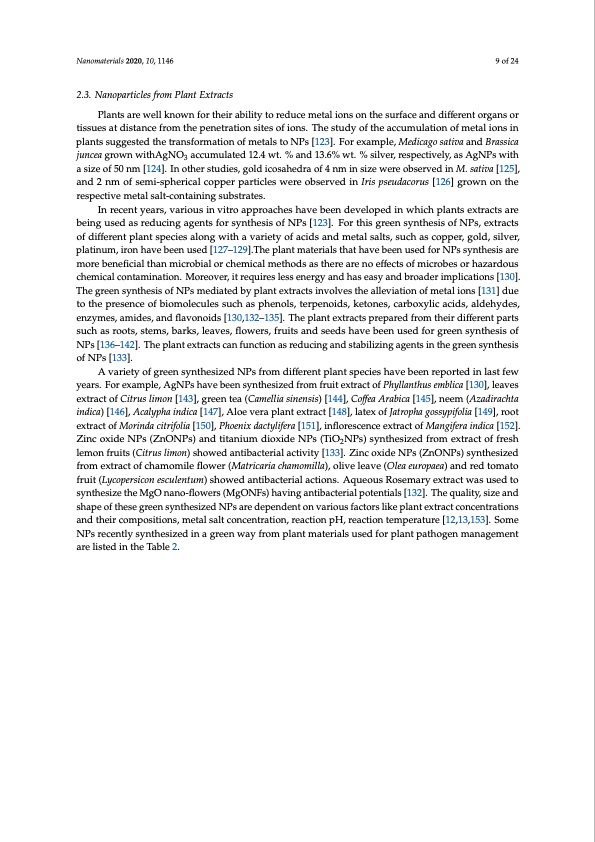
PDF Publication Title:
Text from PDF Page: 009
Nanomaterials 2020, 10, 1146 9 of 24 2.3. Nanoparticles from Plant Extracts Plants are well known for their ability to reduce metal ions on the surface and different organs or tissues at distance from the penetration sites of ions. The study of the accumulation of metal ions in plants suggested the transformation of metals to NPs [123]. For example, Medicago sativa and Brassica juncea grown withAgNO3 accumulated 12.4 wt. % and 13.6% wt. % silver, respectively, as AgNPs with a size of 50 nm [124]. In other studies, gold icosahedra of 4 nm in size were observed in M. sativa [125], and 2 nm of semi-spherical copper particles were observed in Iris pseudacorus [126] grown on the respective metal salt-containing substrates. In recent years, various in vitro approaches have been developed in which plants extracts are being used as reducing agents for synthesis of NPs [123]. For this green synthesis of NPs, extracts of different plant species along with a variety of acids and metal salts, such as copper, gold, silver, platinum, iron have been used [127–129].The plant materials that have been used for NPs synthesis are more beneficial than microbial or chemical methods as there are no effects of microbes or hazardous chemical contamination. Moreover, it requires less energy and has easy and broader implications [130]. The green synthesis of NPs mediated by plant extracts involves the alleviation of metal ions [131] due to the presence of biomolecules such as phenols, terpenoids, ketones, carboxylic acids, aldehydes, enzymes, amides, and flavonoids [130,132–135]. The plant extracts prepared from their different parts such as roots, stems, barks, leaves, flowers, fruits and seeds have been used for green synthesis of NPs [136–142]. The plant extracts can function as reducing and stabilizing agents in the green synthesis of NPs [133]. A variety of green synthesized NPs from different plant species have been reported in last few years. For example, AgNPs have been synthesized from fruit extract of Phyllanthus emblica [130], leaves extract of Citrus limon [143], green tea (Camellia sinensis) [144], Coffea Arabica [145], neem (Azadirachta indica) [146], Acalypha indica [147], Aloe vera plant extract [148], latex of Jatropha gossypifolia [149], root extract of Morinda citrifolia [150], Phoenix dactylifera [151], inflorescence extract of Mangifera indica [152]. Zinc oxide NPs (ZnONPs) and titanium dioxide NPs (TiO2NPs) synthesized from extract of fresh lemon fruits (Citrus limon) showed antibacterial activity [133]. Zinc oxide NPs (ZnONPs) synthesized from extract of chamomile flower (Matricaria chamomilla), olive leave (Olea europaea) and red tomato fruit (Lycopersicon esculentum) showed antibacterial actions. Aqueous Rosemary extract was used to synthesize the MgO nano-flowers (MgONFs) having antibacterial potentials [132]. The quality, size and shape of these green synthesized NPs are dependent on various factors like plant extract concentrations and their compositions, metal salt concentration, reaction pH, reaction temperature [12,13,153]. Some NPs recently synthesized in a green way from plant materials used for plant pathogen management are listed in the Table 2.PDF Image | Plant and Microbe-Based Synthesis of Metallic Nanoparticles

PDF Search Title:
Plant and Microbe-Based Synthesis of Metallic NanoparticlesOriginal File Name Searched:
nanomaterials-10-01146.pdfDIY PDF Search: Google It | Yahoo | Bing
Turbine and System Plans CAD CAM: Special for this month, any plans are $10,000 for complete Cad/Cam blueprints. License is for one build. Try before you buy a production license. More Info
Waste Heat Power Technology: Organic Rankine Cycle uses waste heat to make electricity, shaft horsepower and cooling. More Info
All Turbine and System Products: Infinity Turbine ORD systems, turbine generator sets, build plans and more to use your waste heat from 30C to 100C. More Info
CO2 Phase Change Demonstrator: CO2 goes supercritical at 30 C. This is a experimental platform which you can use to demonstrate phase change with low heat. Includes integration area for small CO2 turbine, static generator, and more. This can also be used for a GTL Gas to Liquids experimental platform. More Info
Introducing the Infinity Turbine Products Infinity Turbine develops and builds systems for making power from waste heat. It also is working on innovative strategies for storing, making, and deploying energy. More Info
Need Strategy? Use our Consulting and analyst services Infinity Turbine LLC is pleased to announce its consulting and analyst services. We have worked in the renewable energy industry as a researcher, developing sales and markets, along with may inventions and innovations. More Info
Made in USA with Global Energy Millennial Web Engine These pages were made with the Global Energy Web PDF Engine using Filemaker (Claris) software.
Infinity Turbine Developing Spinning Disc Reactor SDR or Spinning Disc Reactors reduce processing time for liquid production of Silver Nanoparticles.
| CONTACT TEL: 608-238-6001 Email: greg@infinityturbine.com | RSS | AMP |